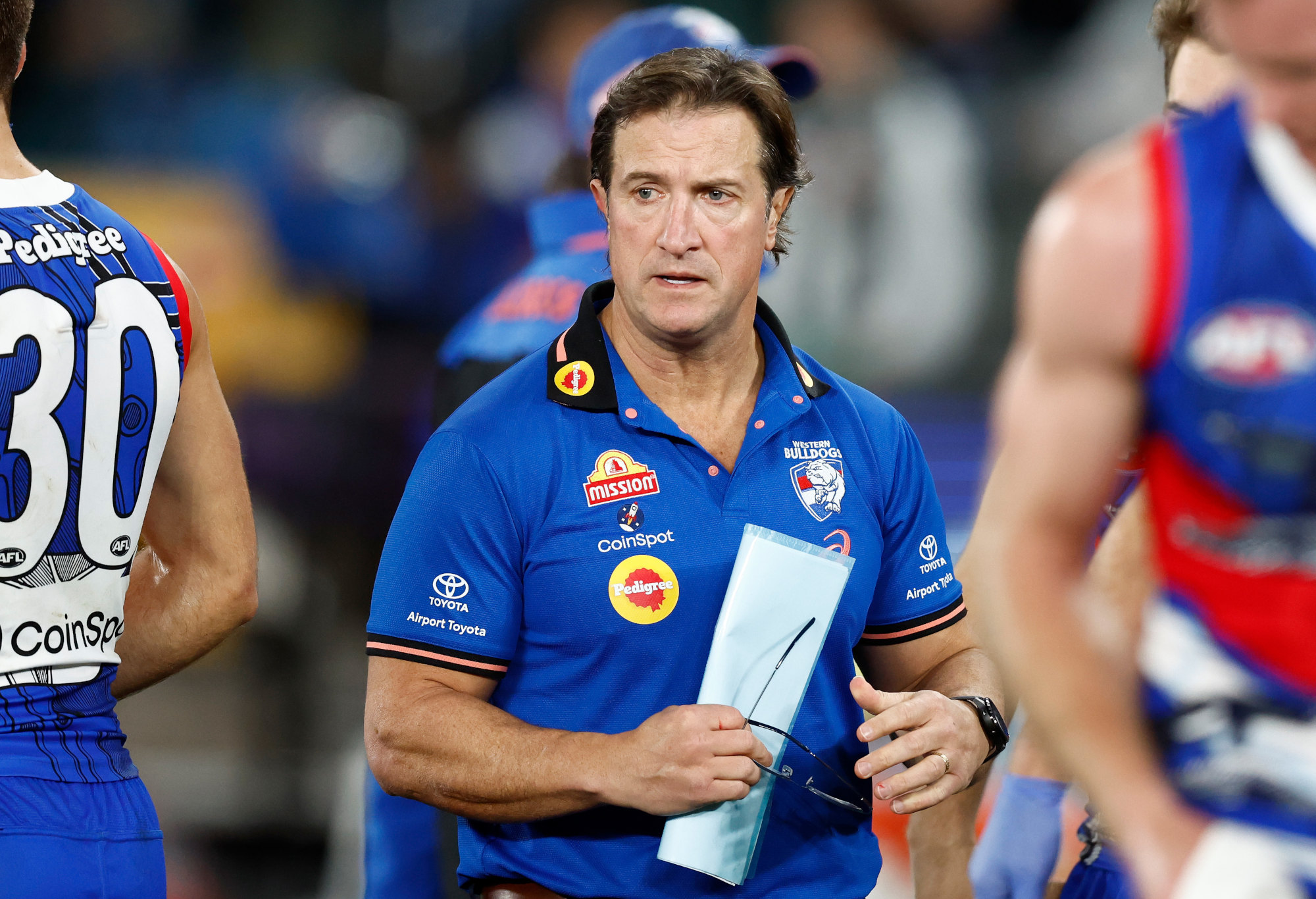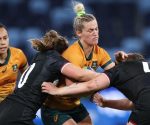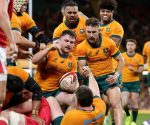Roo’s ridiculous suspension demands MRO overhaul, and are the Blues … back?
They say Round 7 is when the ladder has begun to take its proper shape – but I bet whoever came up with that didn’t know Opening Round was coming.
16 teams have now played seven games – Gold Coast and Essendon are, of course, stuck on six – and we’re starting to learn who’s hot and who’s not.
Collingwood? Hot. Gold Coast? Hot enough to kick ten goals in a row after giving Sydney a start. The Bulldogs? Definitely hot, with or without Sam Darcy.
West Coast? Not. St Kilda? Rapidly cooling. Adelaide? Not cold just yet, but looking dangerously tepid.
From resurgent Blues to controversial suspensions and yet more jumper clash farces, there’s plenty to unpack. Let’s begin.
1. There’s no point in re-signing Bevo now
After spending the better part of three years in the footy hot seat, it must be nice for Luke Beveridge to not have consistent scrutiny on his coaching future.
In the last year of his Western Bulldogs contract, when his job, literally, has never been less secure, Beveridge is coaching the lights out, marshalling an injury-ravaged team to a creditable 4-3 record after seven rounds – including a pair of narrow losses to first and second on the ladder in Collingwood and Brisbane.
The Bulldogs’ win over GWS was their – and Beveridge’s – most impressive win yet; dominant in the midfield, well-organised structurally and able to cover for both Sam Darcy’s injury up front and Liam Jones’ omission down back, the Dogs were too tough and too slick for a Giants outfit many have in premiership contention.
Naturally, the dominant win has led to calls for Bevo’s contract situation to be immediately resolved by the club – so it might surprise you to learn that, as a resolute Beveridge defender over the last three years in this column, I’d be against being so hasty.
For one thing, it’s Round 7: the Dogs have started well, but they’re still only clinging to the edge of the eight. Losing to Port Adelaide, a bogey side, in Ballarat next week, will likely tumble them down the ladder again.
However well the Bulldogs are playing right now, consistent form is something that has eluded this team in recent years: in 2023, for instance, they started 7-3 and looked good for a top-four finish, only to miss the eight altogether.
The club would come in for a barrage of criticism if they re-signed Beveridge now, only to endure a mediocre rest of the season and, in a competitive year for finals placings, either miss the eight or again loss an elimination final in unedifying fashion.
The Bulldogs hierarchy knew what they were doing when they opted not to extend Beveridge’s contract and allow things to play out in the last year of his current deal.
As far as messages go, it’s pretty clear: wait and see what the season has in store, and then make the call either way.
To hold firm to that wouldn’t be disrespectful at all to Beveridge, regardless of whether other clubs are interested in trying to poach him – even though he has publicly refuted claims of a link with Melbourne and said he would take a break from coaching if not at the Dogs next season.
It also surely wouldn’t impact the players, despite their clear love for the coach – if anything, wouldn’t still being able to influence his coaching future inspire the group to play better, as it did for Port Adelaide with Ken Hinkley in 2023, rather than destabilise them?
To re-sign Beveridge off the back of a strong few weeks would be a knee-jerk reaction with potentially ruinous consequences. All things considered, it’s far more prudent to wait and see how 2025 unfolds before deciding.

Luke Beveridge. (Photo by Michael Willson/AFL Photos via Getty Images)
2. Where do the Swans go from here?
12 months on from Brisbane’s spectacular season turnaround and eventual premiership, it would be foolish to write off a reigning grand final loser because of a poor start to the year.
But there’s no denying Sydney are in a proper rut, and after the most disastrous display of their year to date in blowing a 25-point lead to be overrun and swamped by Gold Coast, it leaves Dean Cox in a seriously tricky situation just seven games into his coaching career.
It’s easy to blame a down run of form on injuries, but it’s pretty clear the Swans have been ravaged to beyond the tipping point: Errol Gulden, Callum Mills and Tom Papley are crucial cogs who have missed almost the entire season to date, while Joel Amartey, Robbie Fox, Taylor Adams and Logan McDonald are other best 22 players who have barely featured.
It leaves Cox in a parlous position in his first season in charge. It would be easy to say he has a plum job given most coaches usually come into the role with their teams either at rock bottom or close to it; the former West Coast ruckman, though, has no grace period owing to the Swans’ recent success under John Longmire.
The question now is, what strings can he pull to keep the Swans hanging tough until the cavalry returns, as Beveridge has done at the Bulldogs?
We saw one late against Gold Coast: Nick Blakey, hitherto in All-Australian form at half-back, was thrust forward with the match all but over, and responded with three final-quarter goals.
His height and strong hands overhead proved a difficult match-up for even the Suns’ stingy defence, and he certainly looks a more natural forward than Tom McCartin.
Sydney have plenty of rebounding defenders – none of Blakey’s calibre, but enough to, in the words of Billy Beane in Moneyball, recreate him in the aggregate.
The Swans are 2-5, but it’s by no means curtains for their season just yet. But in the medium term at least, plenty has got to be fixed for last year’s runner-up to get back to their best … that is, if the humiliation of two grand final thrashings in three years hasn’t broken them.
3. Are the Blues … back?
Wins over North Melbourne and West Coast, emphatic to ignore, were easy to overlook given the quality of the opposition.
But Carlton’s triumph over an in-form Geelong on Sunday afternoon at the MCG has me concerned.
With Harry McKay back and combining with Charlie Curnow for one of the few times since late last year amid injury woes for both of them, the Blues looked lethal enough in attack to capitalise on the total stoppage dominance their midfield had over the Cats’.
Patrick Cripps and George Hewett were utterly enormous in the final quarter – Hewett’s game-icing 50m set shot in the last quarter is something I didn’t know he had in his kit bag – while Jacob Weitering was again phenomenal in defence and Mitch McGovern had quite possibly the best game of his topsy-turvy career.
Tom De Koning seems to save his best for Geelong, too; an utter monster in the ruck and around the ground, he was clearly the best man afield – and made St Kilda’s monstrous contract offer to him look like value for money.
Victory was impressive on two fronts: to overwhelm a quality Cats outfit with a dominant first three quarters was a reminder of the Blues’ fearsome power at their best, while the way they responded to Geelong’s frenetic start to the last quarter, which surely would have brought back all the memories of their woeful finishes to matches this year, was arguably even more gladdening to navy blue hearts.
Remarkably, Carlton are the only team this year which has led at half time in every match they’ve played.
At 3-4, their season was by no means past the point of no return: with a handy-looking draw ahead of them, including games against the Kangaroos and Eagles again, there’s a real chance they can surge back up the ladder.
And we all remember from 2023 just how devastating the Blues can be when the wind is in their sails.
4. The REAL reason why Collingwood play at so few venues
Over the last few weeks, a social media trend – led, of course, by GWS’ media team – has started to ridicule the amount of venues other clubs play at compared to Collingwood.
It has forced me to do something that I consider to be borderline heresy – defend the Magpies.
To state the obvious: yes, the Pies do play at very few venues compared to other clubs, particularly Gold Coast and GWS.
Harvey Thomas has played at more grounds in 25 career games than Scott Pendlebury in 410; David Swallow, the AFL record-holder, has 22 venues to his name, including matches in Townsville and Tasmania, Mount Barker and Ballarat, and of course China.
But there’s a pretty obvious reason for this – and every other team in the AFL is responsible for it.
For one thing, Collingwood have just one home ground – the MCG. Unlike the Giants, they don’t play a portion of their home games in Canberra, or Ballarat for the Bulldogs, or Darwin for Gold Coast. They don’t need the money to sell them, nor do they need a second supporter base – it’s the benefit of being the biggest club in the land.
For another, every single other club views a match against the Magpies as a marquee game. Hawthorn aren’t wasting a Pies game in front of 15,000 in Launceston when they could get 75,000 to the MCG; ditto Geelong in Geelong.
GWS, the instigators of the venue complaints, aren’t asking to play Collingwood, the only club aside from Sydney to regularly pull a crowd at ENGIE Stadium, at Manuka Oval, are they? That’s reserved for clubs like the Bulldogs, St Kilda, North Melbourne and non-Victorian teams with smaller membership bases like the Suns, Fremantle and Brisbane.
It’s a bit rich for the Giants in particular to make this complaint, given for the last two years they’ve benefitted from playing the Magpies as their Opening Round fixture, with the sole purpose of getting a sizeable crowd to start the year. Notably, those two games are in the top nine for highest AFL attendances at the Showground, behind six games against Sydney and the famous Giants-Bulldogs 2016 preliminary final.
No doubt the Pies have structural benefits because of their massive size and stature – but every other club seems perfectly happy to harness that when it suits them, as the Bulldogs did for their centenary celebrations, as a race MCG home game against the black and white army yielded them their biggest ever home-and-away crowd.
Much as it pains me to take the Magpies’ side in this, we can’t have our cake and eat it too.
5. Roo’s ridiculous suspension must bring MRO overhaul
Paul Curtis should not have been suspended for three weeks for his tackle on Josh Sinn.
And the fact that he is, in my view, nearly certain to have it overturned on Tuesday night at the Tribunal, where North Melbourne will almost certainly take the case, is just as problematic.
The system with which Match Review Officer Michael Christian operates is fundamentally flawed, and proportion is a key part of it.
The biggest issue with Curtis’ ban is that it was either going to be three games, if deemed a reportable offence, or zero if not.
I think most people could accept that a tackle resulting in a suspension, in nearly all circumstances, will result in one game on the sidelines. North might even have considered not challenging it.
But three games is patently ridiculous, for something that could well have won Curtis a holding the ball free kick.
This isn’t Christian’s fault, either – it’s an issue, once again, with the rigid and inflexible guidelines by which he has to operate.
What Curtis did indisputably made high contact and had the severe impact of a concussion – but was it careless? What else was he meant to do in that situation?
The solution for me, as I’ve said before, is to add an ‘accidental’ clause to the guidelines, as an alternative to ‘careless’ for more reckless actions where someone getting hurt was virtually unavoidable – like, say, Conor Nash on Gryan Miers last week.
Under this clause, the maximum suspension a player can get would be a week’s suspension – which, as it happens, pretty much fits the Curtis case.
The problem with things remaining as they are is that clubs are duty bound to challenge such suspensions, and with plenty of them getting off, the intent of the bans – to stamp such incidents out of the game – is getting lost.
It’s well past time to fix that.

Paul Curtis’ tackle on Josh Sinn left the Port Adelaide defender with a concussion. (Photo by James Elsby/AFL Photos via Getty Images)
6. It’s time to address the farcical jumper clash problem
We’ve already seen plenty of ridiculous jumper clashes this season, but the sight of Collingwood, decked out in a predominantly white jumper with black shorts, facing a predominantly black-jumpered with white shorts Essendon was laughably farcical.
The reason, I suspect, is that Essendon don’t have a viable away strip to provide enough of a contrast.
In this day and age, that’s ridiculous.
It’s time for the league to mandate every club have a ‘clash’ jumper – in fact, just call it an away guernsey, like most other competitions around the world do.
In the NRL, for instance, Penrith have a pink jumper that they regularly wear as a contrast to the black – the away colours don’t even have to have anything to do with your current jumper, to be fair.
This isn’t even about aesthetics – it’s about function. I reckon there were three or four incidents on Friday where Bomber players mistook a Collingwood opponent for a teammate.
If clubs can bring out Anzac Day-inspired jumpers with minimal issues, it shouldn’t be hard at all to expect them to manufacture a bona fide away jumper that they wear for all non-home games. Hell, they might make some merchandising money from it, too.
Random thoughts
– Fair play to Tim English – his ruckwork has improved tremendously this year.
– Nick Haynes might not be washed after all.
– Andrew Brayshaw should be the Brownlow favourite right now. Sneakily having an incredible season.
– Was that just the best game of Mabior Chol’s life?
– I’m not going to go into details, but safe to say there’s an interesting correlation between people attacking Alex Pearce for an Instagram post who don’t have anything to say about certain Sydney players with controversial social media follows…










